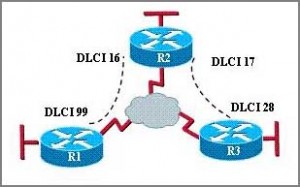Here you will find answers to WAN Questions
Question 1
The command frame-relay map ip 10.121.16.8 102 broadcast was entered on the router. Which of the following statements is true concerning this command?
A: This command should be executed from the global configuration mode.
B: The IP address 10.121.16.8 is the local router port used to forward data.
C: 102 is the remote DLCI that will receive the information.
D: This command is required for all Frame Relay configurations.
E: The broadcast option allows packets, such as RIP updates, to be forwarded across the PVC.
Correct Answers: E
Explanation:
The command frame-relay map ip 10.121.16.8 102 broadcast means to mapping the distal IP 10.121.16.8 102 to the local DLCI 102. When the “broadcast” keyword is included, it turns Frame Relay network as a broadcast network, which can forward broadcasts
Question 2
Refer to the exhibit. Which statement describes DLCI 17?
A: DLCI 17 describes the ISDN circuit between R2 and R3.
B: DLCI 17 describes a PVC on R2. It cannot be used on R3 or R1.
C: DLCI 17 is the Layer 2 address used by R2 to describe a PVC to R3.
D: DLCI 17 describes the dial-up circuit from R2 and R3 to the service provider.
Correct Answers: C
Explanation:
DLCI stands for Data Link Connection Identifier. DLCI values are used on Frame Relay interfaces to distinguish between different virtual circuits. DLCIs have local significance because the identifier references the point between the local router and the local Frame Relay switch to which the DLCI is connected.
Question 3
A default Frame Relay WAN is classified as what type of physical network?
A: point-to-point
B: broadcast multi-access
C: nonbroadcast multi-access
D: nonbroadcast multipoint
E: broadcast point-to-multipoint
Correct Answer: C
Explanation:
Non-Broadcast Multi-Access (NBMA) networks are types such as Frame Relay, X.25, and Asynchronous Transfer Mode (ATM). These networks allow for multi-access, but have no broadcast ability like Ethernet
Question 4
Which of the following are key characteristics of PPP? (Choose three.)
A: can be used over analog circuits
B: maps Layer 2 to Layer 3 address
C: encapsulates several routed protocols
D: supports IP only
E: provides error correction
Correct Answers: A C E
Explanation
No more explanation needed, below is some more information about PPP:
PPP (Point-to-Point Protocol) allows authentication such as Password Authentication Protocol (PAP) and Challenge Handshake Authentication Protocol (CHAP) and multilink connections (allow several separate physical paths to appear to be one logical path at layer 3) and can be run over asynchronous and synchronous links.

